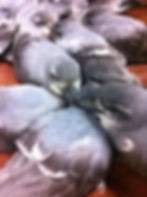Three potential impacts of climate change on wild birds
- Learn Bird Care
- Oct 14, 2021
- 3 min read
I was recently asked to speak about the threats to biodiversity from climate change as part of a regional “Climathon” event – part of a series of global events on climate action. It got me thinking about the climate change impacts we already see in wild birds and the potential flow-on effects to people caring for sick or injured birds. I focus on a few of the potential and known impacts below, and what you can do to help.
1. Impacts on food supply – starvation events
Global climate events already occur from year to year, such as La Nina weather patterns that in New Zealand impact birds of the oceans. Penguins and other seabirds can suffer from starvation due to warming at the ocean surface, leading to fish seeking cooler waters and thus being harder to hunt. Severe storm events can also lead to starvation as birds are unable to rest or feed. With climate change, sea temperature increases and sea-level rise, this may exacerbate these effects, and we may see mass starvation have population impacts, and juveniles are often the most inexperienced at hunting and suffer quickly when food supplies are short.


How you can help:
If you are a wildlife rehabilitator, look ahead to the predicted season. Prepare by resourcing or planning for additional food needs if a starvation event is expected. It will be best to negotiate a plan with your food supplier in case the food is not needed.
Get involved with protecting the oceans from other damaging effects such as plastic pollution and reducing the impacts of fishing on seabirds. These are things we can do something about to help reduce pressures on stressed populations.

2. Impacts of temperature rise – droughts, heat stress, fires
Many species can suffer from direct heat stress when overt temperatures reach extremes. Additionally, prolonged warming events can cause droughts, and for some species, this can mean decreased food or water availability. We already see this annually in the northern part of New Zealand, where kiwi are seen out drinking from water troughs or feeding during the day (unusual), and it often makes the news. But if kiwi are suffering, you can be sure that other species are too. We have also seen the devastating impacts of fires on Australian and American wildlife with scarily large bush fires causing severe injuries and death of billions of animals.
How you can help:
Reforestation – healthy forests help to sink carbon, provide cooling temperatures and protect and improve the soil.
Fire safety – use extreme caution during drought to prevent man-made fires, and have a fire plan in place. Indigenous methods of fire management are on the uprise for preventing wildfires in several countries.
Upskill in wildlife rescue and rehabilitation to be able to help your local rescue group in the event of a fire.
Drought – consider leaving water out for wildlife to access, preferably clean water in shallow trays that they cannot drown in. Change and refill daily.
3. Impacts of pest and disease migration
Changes in global climate may allow some diseases (or the insects that carry them, such as ticks and mosquitoes) to expand their range or enter new areas. It may mean the disease is seen in new species or diseases affecting more animals that might once have been relatively protected by their environment. Similarly, exotic pests including insects, rodents or other animals may expand their range or be able to survive where previously they couldn’t, which may impact local biodiversity.

How you can help:
Wildlife rehabilitators can be at the forefront of wildlife disease surveillance. Get connected with your government agency or any groups interested or responsible for animal disease surveillance and response. Keep good records of animals in your care and report anything unusual.
Anyone can help by ensuring that unusual diseases, exotic pests or mass animal deaths are reported. In New Zealand, you can report to the MPI Exotic Pest & Disease Hotline: 0800 80 99 66.
In essence, you can see that people who care for birds and other wildlife will be at the forefront of the response to the effects of climate change. We need to prepare for the worst but hope for the best - but not forget to take real action in our everyday lives to drastically reduce our carbon footprint.
Written by Janelle Ward
Wildlife Veterinarian & Co-founder of Learn Bird Care Ltd.
Would you like to learn to care for wild birds and be another helping hand? Why not try one of our courses and take that next step to help a bird in need? Wild Bird Rescue 101 gives you the tools and knowledge for the rescue, handling, transport and first aid for sick or injured wild birds.
To stay in touch and find out about new blog posts and courses as they are released, register for our free newsletter today and you will receive our ' Basic Bird Rescue and Initial Care' booklet!


